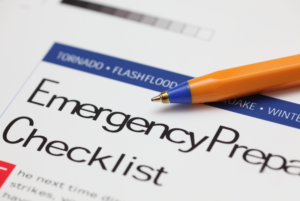09.12.2023
Developing Organizational Preparedness
 National Preparedness Month is a reminder of the importance of readiness in the face of unforeseen challenges. At FTI, where safety and reliability are paramount, being prepared is not just a responsibility; it’s a necessity. Emergency preparedness refers to the comprehensive plans and actions taken to mitigate, respond to and recover from emergencies or disasters. It is a continuous cycle of planning, organizing, training, equipping, exercising, evaluating and improving. It involves identifying potential risks, developing strategies and ensuring resources are in place to safeguard lives, property and business operations.
National Preparedness Month is a reminder of the importance of readiness in the face of unforeseen challenges. At FTI, where safety and reliability are paramount, being prepared is not just a responsibility; it’s a necessity. Emergency preparedness refers to the comprehensive plans and actions taken to mitigate, respond to and recover from emergencies or disasters. It is a continuous cycle of planning, organizing, training, equipping, exercising, evaluating and improving. It involves identifying potential risks, developing strategies and ensuring resources are in place to safeguard lives, property and business operations.
You may be asking yourself: why should I take time to learn about emergency preparedness at work when I already have so many things on my plate? We can just “wing it,” right? As with safety, being informed and proactive in this area is not just a professional duty but also a personal responsibility that can have far-reaching benefits. Emergency preparedness directly impacts an individual’s safety, the safety of their colleagues, job security and the overall resilience of the organization. Leadership and team member involvement is also crucial for maintaining business continuity. When everyone understands their roles and responsibilities during an emergency, they can help ensure that critical functions continue, minimizing downtime and financial losses. Finally, knowing that your workplace is prepared for emergencies can provide peace of mind, alleviating anxiety and stress related to potential disasters.
Understanding the risks and hazards within the construction and electrical industries is an important step toward organizational preparedness. Risks and hazards include:
- Human-caused: i.e., armed assailant events, cyber-attacks, theft, civil disturbances
- Natural: i.e., flooding, hurricanes, tornadoes, ice storms, wildfires
- Technological: i.e., equipment failures, utility interruptions, control systems malfunctions, project-specific risks
The impacts of these risks range from project delays and financial losses to potential harm to team members and clients. At FTI, we conduct both risk assessments and Business Impact Analysis (BIA) to better understand how to plan for and mitigate the impact of these hazards. Understanding the hazards and risks facing our organization helps guide emergency response planning and business continuity planning. To remain proactive and effectively guide our strategies, we review risks and update the BIA on an annual basis.
What else are we doing to develop preparedness within FTI? In 2019, FTI began developing the cornerstone of our organizational preparedness—a Business Continuity Plan (BCP). In short, our BCP is a comprehensive plan that outlines how each department will continue its critical functions during and after a disaster. The BCP has evolved over the past few years as we better understand how to meet challenges within our industries and will continue to grow and change in the future as we seek to develop resiliency and a culture of preparedness at FTI.
We have learned that a solid business continuity program is built through collaboration, communication and coordination across the organization and within the communities where we work. We also know that being prepared is an on-going, multifaceted endeavor. It requires more than a one-time plan; team members must understand their roles through training and proper communication, plans must be tested through exercises and emergency drills and the program must be evaluated and improved through on-going assessments. As we continue to understand the potential risks and impacts for not just FTI, but also for our partners, we will continue to adapt and up-date our strategies so that essential operations continue, we mitigate injuries and downtime, and minimize financial losses if an incident occurs.
This September, let’s use National Preparedness Month as a reminder that preparation is not a one-size-fits-all concept. From identifying industry-specific risks to implementing a robust BCP and promoting personal preparedness among team members, it’s clear that readiness is essential for safety, reliability and resilience.
If you enjoyed this blog article, please subscribe to stay up to date on the latest industry news from our experts at Faith Technologies.



